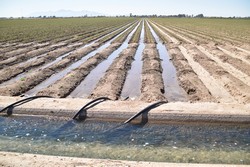Impact of irrigation and land-use change on soil inorganic carbon
Earlier research has shown large losses of soil inorganic carbon following land-use changes, which has the potential to transform the current understanding of carbon sequestration. The ELSIC (Ecosystem loss of soil inorganic carbon with agricultural conversion: Fate, rate, mechanisms, and pathways) project investigated how soil hydrology, through land-use changes, can alter the dynamics of carbonates in soil development. To understand the effects of agriculture on soil inorganic carbon, we measured radiocarbon and stable isotope profiles of pedogenic carbonates in deep-soil profiles from irrigated croplands and compared these with nearby natural, non-irrigated grasslands. Specifically, we aimed to determine the potential fate of inorganic carbon dissolved by irrigation - whether it re-precipitates deeper in the soil, or is leached into groundwater, and what the net effect is on atmospheric carbon dioxide. Although there was clearly loss of soil inorganic carbon near-surface, there was no large increase in younger carbon transported downward in soil profiles in irrigated soils past 2-m depths, indicating that dissolution may have occurred at much greater rate than reprecipitation of soil inorganic carbon. Age of the soil inorganic carbon at these depths were up to ~10,000 years old, indicating that they were formed and persisted under the drier climate of the Holocene period and may be vulnerable to changes in soil water flux from agricultural irrigation or climate change. Results from our incubation and modeling experiments indicate much greater portion of inorganic carbon leaving as leachate to groundwater than degassing as atmospheric carbon dioxide. Radiocarbon was also used to study the age of carbon in fine roots from a number of deep profiles under tree plantations. Root ages ranged from 1-10 years, within the ranges observed in the literature. Radiocarbon of fine roots fluctuated with depth, with young carbon in the top 20 cm and 2-3 m of the soil profile, with older roots immediately below those depths. Similar fluctuations in root age or longevity with depth have been observed in the literature. Different temporal variability of resources along the soil profile may be a potential factor that can be tested with temporal measurements at these and other sites.







